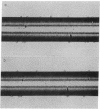Abstract
Thymus-derived lymphocytes (T cells) and bone marrow-derived lymphocytes (B cells) from mouse spleens bind specifically to antigen-derivatized nylon fibers. The fiber-bound population consisted of about 60%-70% B cells and 30% T cells as determined by cytotoxicity, fluorescence, and antibody-complement binding assays. Essentially all fiber-bound cells were viable and could be accounted for as T or B cells. Enriched populations of T or B cells could be isolated on the fibers by destruction of one or the other cell type with the appropriate antiserum plus complement. T or B cells could also be fractionated according to their relative affinity (or avidity) for a given antigen.
Keywords: mouse spleen, nylon fibers, antiserum, cytotoxicity, fluorescence
Full text
PDF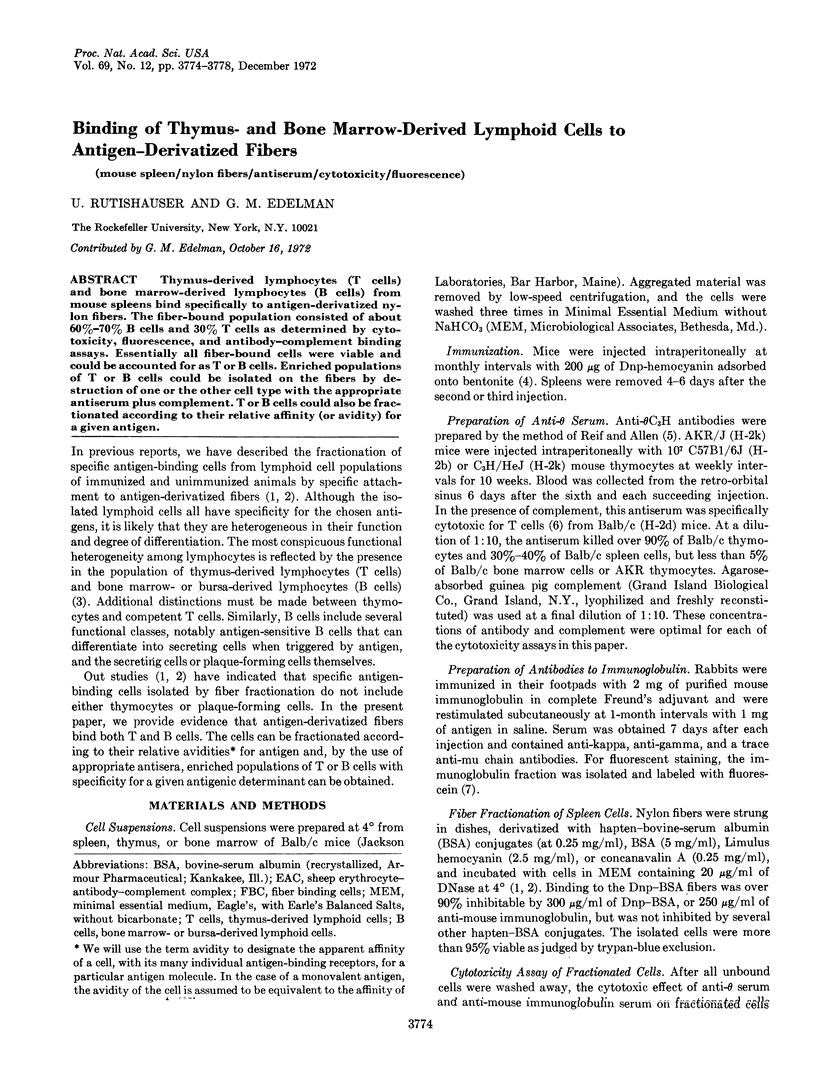
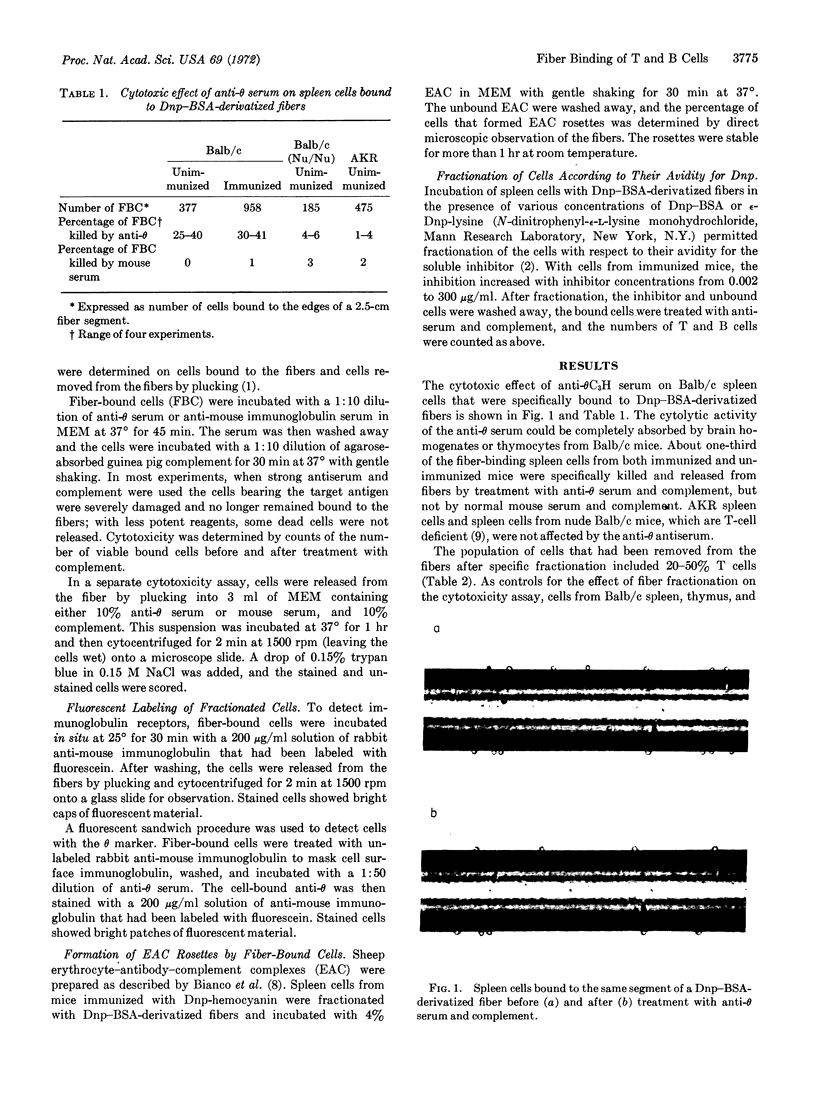
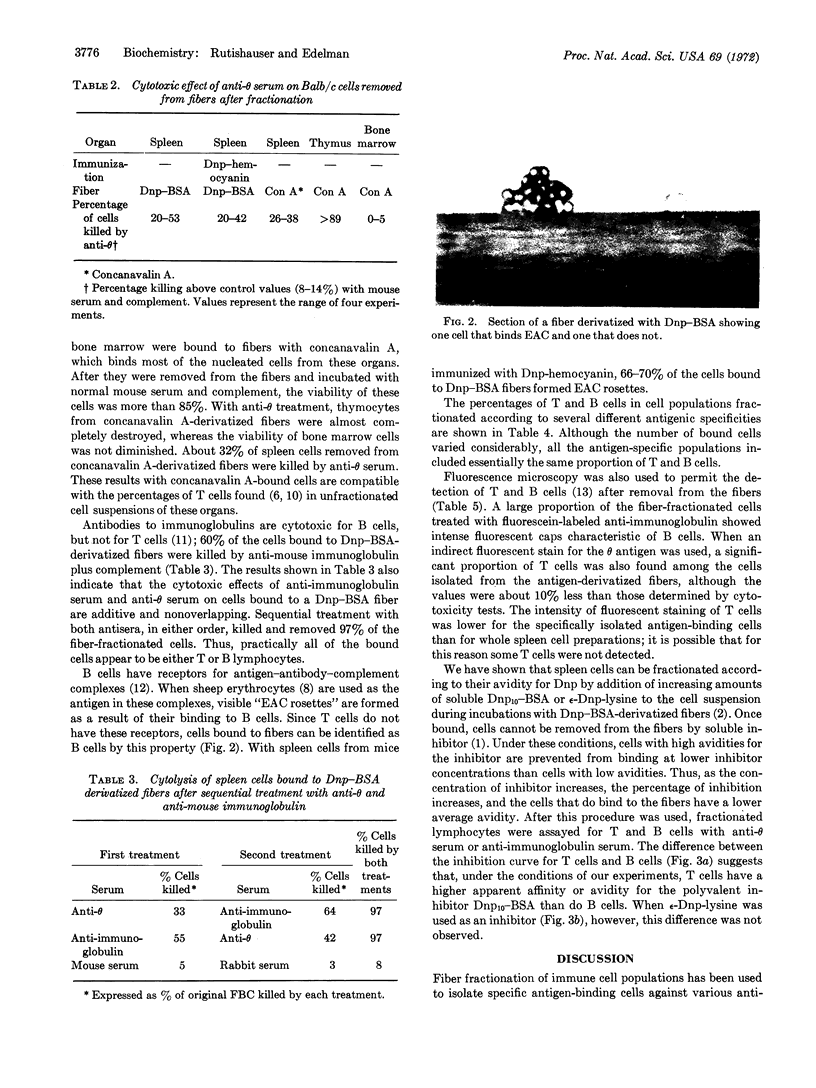
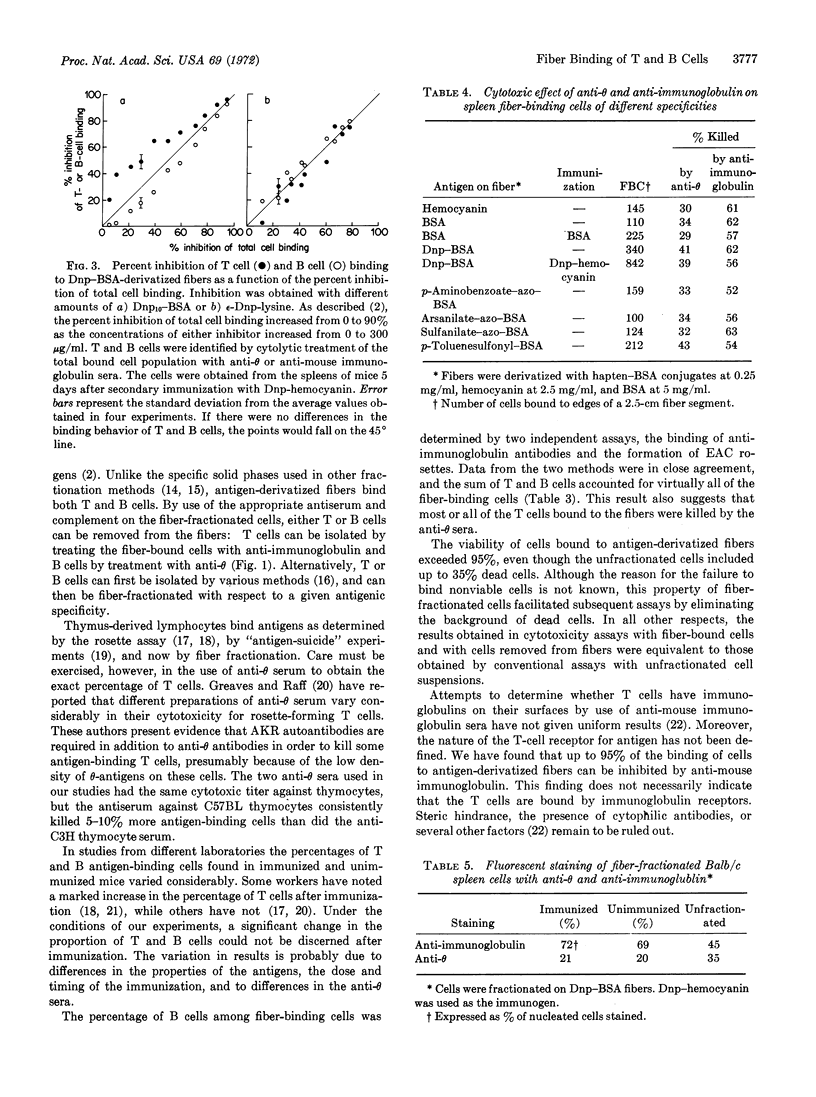

Images in this article
Selected References
These references are in PubMed. This may not be the complete list of references from this article.
- Basten A., Miller J. F., Warner N. L., Pye J. Specific inactivation of thymus-derived (T) and non-thymus-derived (B) lymphocytes by 125I-labelled antigen. Nat New Biol. 1971 May 26;231(21):104–106. doi: 10.1038/newbio231104a0. [DOI] [PubMed] [Google Scholar]
- Bianco C., Nussenzweig V. Theta-bearing and complement-receptor lymphocytes are distinct populations of cells. Science. 1971 Jul 9;173(3992):154–156. doi: 10.1126/science.173.3992.154. [DOI] [PubMed] [Google Scholar]
- Bianco C., Patrick R., Nussenzweig V. A population of lymphocytes bearing a membrane receptor for antigen-antibody-complement complexes. I. Separation and characterization. J Exp Med. 1970 Oct 1;132(4):702–720. doi: 10.1084/jem.132.4.702. [DOI] [PMC free article] [PubMed] [Google Scholar]
- Cebra J. J., Goldstein G. Chromatographic purification of tetramethylrhodamine-immune globulin conjugates and their use in the cellular localization of rabbit gamma-globulin polypeptide chains. J Immunol. 1965 Aug;95(2):230–245. [PubMed] [Google Scholar]
- Crone M., Koch C., Simonsen M. The elusive T cell receptor. Transplant Rev. 1972;10:36–56. doi: 10.1111/j.1600-065x.1972.tb01538.x. [DOI] [PubMed] [Google Scholar]
- Edelman G. M., Rutishauser U., Millette C. F. Cell fractionation and arrangement on fibers, beads, and surfaces. Proc Natl Acad Sci U S A. 1971 Sep;68(9):2153–2157. doi: 10.1073/pnas.68.9.2153. [DOI] [PMC free article] [PubMed] [Google Scholar]
- Greaves M. F., Möller E. Studies on antigen-binding cells. I. The origin of reactive cells. Cell Immunol. 1970 Oct;1(4):372–385. doi: 10.1016/0008-8749(70)90015-8. [DOI] [PubMed] [Google Scholar]
- Mandel T. E. Intramembraneous marker in T lymphocytes. Nat New Biol. 1972 Sep 27;239(91):112–114. doi: 10.1038/newbio239112a0. [DOI] [PubMed] [Google Scholar]
- Miller J. F., Basten A., Sprent J., Cheers C. Interaction between lymphocytes in immune responses. Cell Immunol. 1971 Oct;2(5):469–495. doi: 10.1016/0008-8749(71)90057-8. [DOI] [PubMed] [Google Scholar]
- Paul W. E. Functional specificity of antigen-binding receptors of lymphocytes. Transplant Rev. 1970;5:130–166. doi: 10.1111/j.1600-065x.1970.tb00359.x. [DOI] [PubMed] [Google Scholar]
- Raff M. C., Owen J. J. Thymus-derived lymphocytes: their distribution and role in the development of peripheral lymphoid tissues of the mouse. Eur J Immunol. 1971 Jan;1(1):27–30. doi: 10.1002/eji.1830010105. [DOI] [PubMed] [Google Scholar]
- Raff M. C. Two distinct populations of peripheral lymphocytes in mice distinguishable by immunofluorescence. Immunology. 1970 Oct;19(4):637–650. [PMC free article] [PubMed] [Google Scholar]
- Raff M. C., Wortis H. H. Thymus dependence of theta-bearing cells in the peripheral lymphoid tissues of mice. Immunology. 1970 Jun;18(6):931–942. [PMC free article] [PubMed] [Google Scholar]
- Raff M. Theta isoantigen as a marker of thymus-derived lymphocytes in mice. Nature. 1969 Oct 25;224(5217):378–379. doi: 10.1038/224378a0. [DOI] [PubMed] [Google Scholar]
- Reif A. E., Allen J. M. Mouse thymic iso-antigens. Nature. 1966 Jan 29;209(5022):521–523. doi: 10.1038/209521b0. [DOI] [PubMed] [Google Scholar]
- Rittenberg M. B., Pratt K. L. Antitrinitrophenyl (TNP) plaque assay. Primary response of Balb/c mice to soluble and particulate immunogen. Proc Soc Exp Biol Med. 1969 Nov;132(2):575–581. doi: 10.3181/00379727-132-34264. [DOI] [PubMed] [Google Scholar]
- Rutishauser U., Millette C. F., Edelman G. M. Specific fractionation of immune cell populations. Proc Natl Acad Sci U S A. 1972 Jun;69(6):1596–1600. doi: 10.1073/pnas.69.6.1596. [DOI] [PMC free article] [PubMed] [Google Scholar]
- Schlesinger M. Anti-theta antibodies for detecting thymus-dependent lymphocytes in the immune response of mice to SRBC. Nature. 1970 Jun 27;226(5252):1254–1256. doi: 10.1038/2261254a0. [DOI] [PubMed] [Google Scholar]
- Takahashi T., Old L. J., McIntire K. R., Boyse E. A. Immunoglobulin and other surface antigens of cells of the immune system. J Exp Med. 1971 Oct 1;134(4):815–832. doi: 10.1084/jem.134.4.815. [DOI] [PMC free article] [PubMed] [Google Scholar]
- Truffa-Bachi P., Wofsy L. Specific separation of cells on affinity columns. Proc Natl Acad Sci U S A. 1970 Jul;66(3):685–692. doi: 10.1073/pnas.66.3.685. [DOI] [PMC free article] [PubMed] [Google Scholar]
- Wigzell H., Andersson B. Cell separation on antigen-coated columns. Elimination of high rate antibody-forming cells and immunological memory cells. J Exp Med. 1969 Jan 1;129(1):23–36. doi: 10.1084/jem.129.1.23. [DOI] [PMC free article] [PubMed] [Google Scholar]
- Wilson J. D., Miller J. F. T and B rosette-forming cells. Eur J Immunol. 1971 Dec;1(6):501–503. doi: 10.1002/eji.1830010622. [DOI] [PubMed] [Google Scholar]



